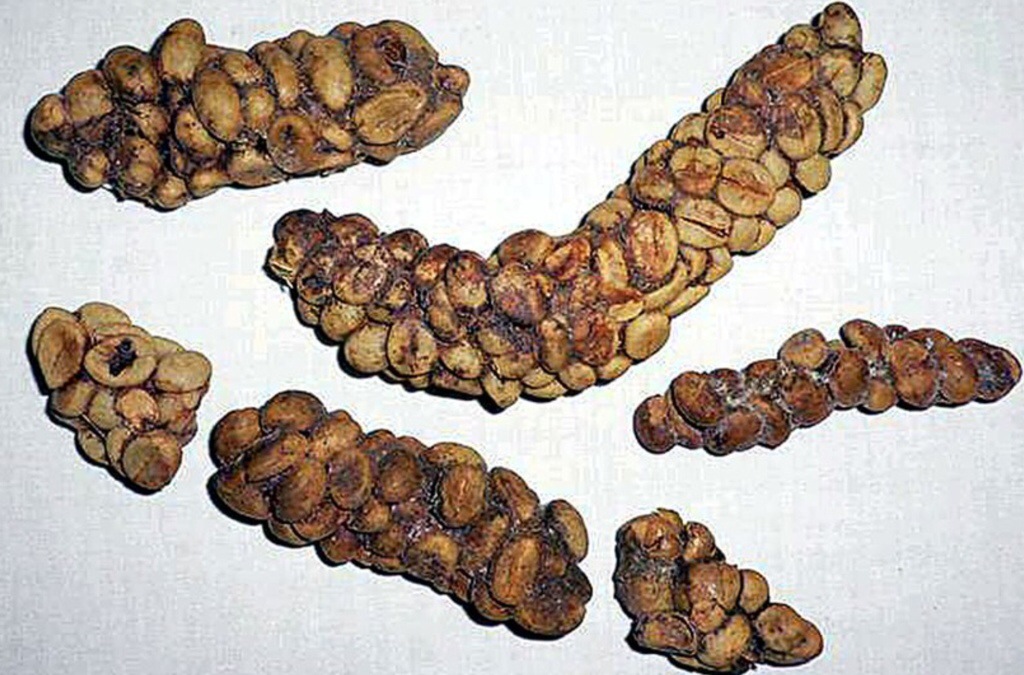Picture if you will a Pyramid – at the base of the pyramid can be found Robusta coffee then, as you climb up, you get Natural Arabica, then Washed Arabica, then speciality coffees – like ‘Kopi Luwak’. The price of the coffee increases the further up the pyramid you go.
Kopi Luwak (Indonesian pronunciation: [ˈkopi ˈlu.aʔ]), or civet coffee, refers to the seeds of coffee berries once they have been eaten and egested by the Asian palm civet. Kopi Luwak can be found in Sumatra, Bali, and Java and is one of the most expensive coffees in the world. The luak, a small catlike animal, gorges after dark, on the most ripe, and best cherries. It digests the fruit and expels the beans, which our collected, washed, and then roasted. A 16 ounce bag would set you back £224.00 or £14.00 an ounce.
However, Colombian coffee is a ‘single origin’ coffee and is of excellent quality and therefore more expensive than blended coffees. It is also more expensive than naturally dried Arabica because of the work involved in the washing process. From harvesting to your home can take up to 1 year. All Colombian coffee is rigorously tested, with only the best being chosen for export. The reason that Colombian coffee cannot be naturally dried is all down to the humidity here.
Coffee is not usually roasted prior to exportation. Each country has it’s own ‘unique’ blending and roasting processes, which depends on the ‘culture’ of that country. In many cases, cheaper Robusta is blended with the more expensive Arabica. Different roasters have different blending strategies. Some use only two to four different coffees; these blends can have very distinct tastes and will vary a lot year to year. Other roasters will try to keep the blend’s taste the same year in, year out. They will do this by using seven to twelve different coffees, many from different plantations in the same country and region, so as to average out the annual variations of coffees from any one plantation.
The Roasting:
Roasting is where the coffee’s flavour is fulfilled. In the majority of cases the roasting process takes place in the country that imports the green coffee (Almond Coffee).
The green coffee beans are heated in large, rotating drums using temperatures of about 550 F (288 C). The tumbling motion of the drums keeps the beans from burning. The beans first turn a yellowish colour and smell a little like popcorn. After about 8 minutes, the beans “pop” and double in size. The beans have then reached about 400 F (204 C) and begin to brown as the oils within them start to emerge. This oil is called coffee essence or caffeol. The chemical reaction of the heat and coffee essence is called pyrolysis, and is what produces the flavour and aroma of coffee. A second “pop” occurs about three to five minutes later and signals that the bean is fully roasted. Roasting changes colour due to sugar Brownings.
When coffee goes through the roasting process it produces different aromas – first like straw, hay, bread, cakes, caramel, pop corn then burnt pop corn then coffee aroma. Roasting involves heat and ventilation. Low roasting produces sweet & acidic coffee, high roasting produces bitter coffee that is less acidic. Robusta coffee contains 2% caffeine, Arabica coffee contains 1% caffeine
Coffee beans will only keep for about 2-weeks after the packet has been opened, due to oxidation. Once opened coffee is best kept in a sealed container in a fridge. Ground coffee will only last for 7 days.
Marketing Colombian Coffee:
Juan Valdez is a fictional character who has appeared in advertisements for the Federation Nacional de Cafeteros de Colombia (National Federation of Coffee Growers of Colombia) since 1958, representing a Colombian coffee farmer. The adverts were designed by the Doyle Dane Bernbach ad agency, with the goal of distinguishing 100%-Colombian coffee from coffee blended with beans from other countries. He typically appears with his mule Conchita, carrying sacks of harvested coffee beans. He has become an icon for Colombia as well as coffee in general.
Other coffee options available:
Instant coffee:
Is made in a huge expresso then the moisture is removed by:
1. Evaporation or by
2. Freeze drying, then removal of the water crystals.
De caffeinated coffee:
The caffeine is removed using one of the following methods:
1. Ethyl Acetate – removes more than just the caffeine!
2. Solvents – removes more than just the caffeine!
3. CO2 – removes the caffeine only, but is a more expensive process.
So the next time you drink a cup of coffee spare a thought for what goes into producing it. The trip coffee takes, from the crop to your cup, turns out not to be straightforward after all, but rather a turbulent and unpredictable ride through the waves and eddies of international commodity dynamics, where the product itself becomes secondary to the wash of money and power.



